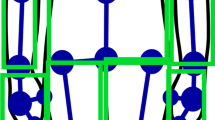Summary
Methods and parameters are described to quantify body sway as measured by a force-transducing platform. Analogue data representing the coordinates of the body's center of force (COF) are fed into a digital computer. The following parameters are then calculated and tested for their diagnostic significance: sway path (SP), mean amplitude of sway (MA), mean sway frequency (MF), their lateral and sagittal components, and the quotients sagittal/lateral of these as well as the sway area (SA) circumscribed by the COF. Quotients of eyes open/eyes closed for all these parameters determine the visual stabilization of posture. Sway position and sway direction histograms allow for a more detailed analysis of MA and SP. Despite considerable inter and intraindividual variance of these parameters (in 28 normals), some of them seem of clinical significance not only for documentation and follow-up studies but also for differential diagnosis.
In patients with cerebellar lesions (n=12), SP and MA were up to 10 times larger with a marked antero-posterior instability, MF being above normal. Patients with labyrinthine lesions (n=10) showed significant instability only with eyes closed, MF being slightly below normal.
Zusammenfassung
Es werden Methodik und Parameter für eine quantitative Auswertung der Standunruhe bei Kranken und Gesunden beschrieben. Aus den Analogsignalen einer Kraftmeßplattform werden die folgenden Daten über die Bewegungen des Körperkraftschwerpunktes digital errechnet: Schwingungsweg (SP), dessen mittlere Amplitude (MA), mittlere Frequenz (MF), die lateralen und sagittalen Komponenten, deren Quotienten und die von den Körperschwankungen umschlossene Fläche (SA). Quotienten der Werte bei offenen und geschlossenen Augen beschreiben die visuelle Standstabilisation. Positions- und Richtungshistogramme dokumentieren zusätzlich die Vorzugsrichtungen der Körperunruhe.
Eine Analyse der Signifikanz dieser Parameter zeigte trotz großer Varianz bei Normalen deren klinische Brauchbarkeit. Patienten mit Kleinhirnerkrankungen (vorwiegend des Vorderlappens) zeigen bis zu 10mal höhere Werte, z. B. für MA und SP vorwiegend in sagittaler Richtung und eine erhöhte mittlere Frequenz (MF), während Patienten mit weitgehend kompensierten Vestibularisläsionen nur bei geschlossenen Augen vermehrt schwanken, wobei MF erniedrigt ist.
Similar content being viewed by others
References
Bensel, C. K., Dzendolet, E.: Power spectral density analysis of the standing sway of males. Percept. Psychophys. 4, 285–288 (1968)
Claussen, C. F.: Über eine Gleichgewichtsfunktionsprüfung mit Hilfe der Craniocorpographie (CCG) und Polarkoordinaten im Raume. Arch. Klin. Exp. Ohren- Nasen- Kehlkopfheilkd. 196, 256–261 (1970)
Dichgans, J., Held, R., Young, L. R., Brandt, Th.: Moving visual scenes influence the apparent direction of gravity. Science 18, 1217–1219 (1972)
Dichgans, J., Mauritz, K.-H., Allum, J. H. J., Brandt, Th.: Postural sway in normals and atactic patients. Analysis of the stabilizing and destabilizing effects of vision. Agressologie 17C, 15–24 (1976)
Edwards, A. S.: The measurement of static ataxia. Am. J. Psychol. 55, 171–188 (1941)
Gurfinkel, E. V.: Physical foundations of the stabilography. Agressologie 14C, 9–14 (1973)
Hellebrandt, F. A.: Standing as a geotropic reflex. Am. J. Physiol. 121, 471–474 (1938)
Hirashawa, Y.: Study of human standing ability. Agressologie 14C, 37–44 (1973)
Kapteyn, T. S.: Data processing of the posturographic curves. Agressologie 13B, 29–34 (1972)
Kapteyn, T. S., Wit, G. de: Posturography as an auxiliary in vestibular investigation. Acta Otolaryngol. (Stockh.) 73, 104–111 (1972)
Lee, D. N., Lishman, J. R.: Visual proprioceptive control of stance. J. Hum. Movement Stud. 1, 87–95 (1975)
Mauritz, K.-H., Dichgans, J., Hufschmidt, A.: Quantitative analysis of stance in late cortical cerebellar atrophy of the anterior lobe and other forms of cerebellar ataxia. Brain 102, 461–482 (1979)
Miles, W. R.: Static equilibrium as a useful test of motor control. J. Ind. Hyg. 3, 316–361 (1922)
Montserrat, S.: Méthode d'objectivation des troubles de la posture et des tremblements par le test oscillométrique. C. R. Acad. Sci. [D] (Paris), 2079–2086 (1969)
Nashner, L. M.: Sensory feedback in human posture control. Dissertation, Massachusetts Institute of Technology (1970)
Njiokiktjien, Ch., van Parys, J. A. P.: Romberg's sign expressed as a quotient, II. Pathology. Agressologie 17D, 19–24 (1976)
Silfverskiöld, B. P.: Romberg's test in the cerebellar syndrome occurring in chronic alcoholism. Acta Neurol. Scand. 45, 292–302 (1968)
Taguchi, K., Jijima, M., Suzuki, J.: Computer calculation of movement of body's center of gravity. Acta Otolaryngol. (Stockh.) 85, 420–425 (1978)
Uchytil, B.: Methode der objektiven Aufzeichnung vestibulospinaler Reflexe. Monatsschr. Ohrenheilkd. Laryngo-Rhinol. 96, 554–558 (1962)
Author information
Authors and Affiliations
Additional information
This work was supported by the Deutsche Forschungsgemeinschaft SFB 70 (Hirnforschung und Sinnesphysiologie)
Rights and permissions
About this article
Cite this article
Hufschmidt, A., Dichgans, J., Mauritz, K.H. et al. Some methods and parameters of body sway quantification and their neurological applications. Arch. Psychiat. Nervenkr. 228, 135–150 (1980). https://doi.org/10.1007/BF00365601
Received:
Issue Date:
DOI: https://doi.org/10.1007/BF00365601




